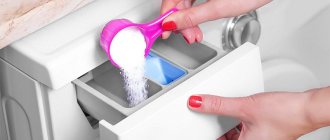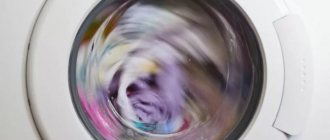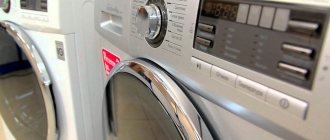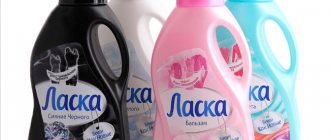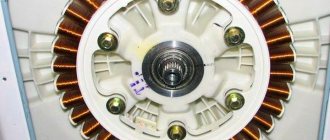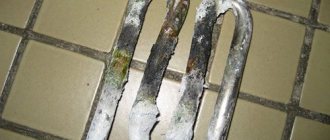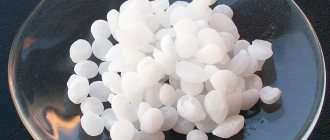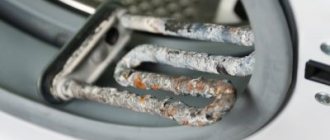Drum cleaning function in LG washing machine
You can solve the problem of contamination by simply turning on the drum cleaning function in the LG washing machine. This is a special program that automatically runs the entire wash cycle at idle speed without laundry, washing the inside of the machine.
It is designed to dissolve particles deposited on the inner surface of the drum and plastic tank and keep them clean. The self-cleaning function is available in LG washing machine models of different price categories.
Scope of application of the cleaning function
The drum, where stale laundry is placed and where detergents get in, is more susceptible to contamination than other parts of the washing machine. It also comes into contact with hard, poorly filtered water containing harmful impurities:
- Iron
- Technical, edible oils
- Rust
- Chlorine
- Calcium and magnesium salts
With frequent use of the machine, especially in large families, the drum constantly remains wet, with puddles and smudges.
An environment favorable for the development of microorganisms and bacteria that pose a threat to health is formed. The situation is aggravated by the habit of some housewives of storing dirty clothes directly in the washing machine.
Regular cleaning of the LG washing machine drum is necessary to get rid of grease, mold and dirty deposits, dissolve fabric particles and lint.
Worth remembering! The function will not rid the heating element (heating element) and drum of scale.
To prevent pieces of delicate fabric from clogging the inside of the machine, they should be washed in special bags.
How does it work?
Many housewives do not know how the drum cleaning function works in the Lg washing machine, trying to get rid of plaque and mold with folk remedies - vinegar, soda and citric acid.
Attention! Conventional products are not safe for parts:
- Vinegar creates an aggressive environment in the drum of the machine, and it must be used very carefully, without exceeding the dosage.
- Citric acid damages the seal around the door and other rubber elements.
- Soda is an alkali; it corrodes aluminum and its alloys. In combination with other chemicals, the aggressive effect is enhanced.
A special built-in function knows how to clean the drum of an LG washing machine without harming the mechanism:
- Pre-wash mode is activated
- Main wash at a temperature of 60 C and a motor speed of 150 rpm
- Spin and rinse twice.
The standard operating time of the program is 1 hour 35 minutes.
Attention! The manufacturer does not recommend adding descaling agents or powder when performing the cleaning function - it causes a large amount of foam, which can lead to leakage.
How to enable the feature?
How to use the function correctly:
- Remove foreign objects
- Close the door
- Simultaneously press 2 buttons “intensive” and “no folds”, marked with an * (asterisk), holding them for 3 seconds until the letters “tei” appear on the indicator.
- Press the “Start” button
- After the program has completed, open the door and wait until the drum is completely dry.
Advice! Before turning on the function, you should inspect the drain hose for blockages and clean the filter.
Source: https://remonteha.ru/stiralnye-mashiny/ocistka-barabana-v-stiralnoj-masine-lg/
When is cleaning the machine clearly necessary?
How do you know when it's time to clean your machine? This is especially important for housewives who have recently started using this device and have not yet gained the necessary experience.
You should immediately notice a pattern - the more often washing is done at high temperatures, the more often the machine needs to be cleaned of limescale deposits.
Scale accumulated on the heating element (heating element)
If during washing you begin to notice signs of deterioration in its quality, then this is a clear indicator that scale or dirt deposits have already accumulated on the machine parts in contact with water:
- When you remove light-colored laundry from the machine after washing, dark stains are found on it that are difficult to wash even by hand - this is a clear sign of scale accumulation.
- Washing clothes for an excessively long time, exceeding the normal cycle, indicates that there is limescale on the heating element. In this case, energy consumption increases, since such mineral deposits have low thermal conductivity, and it takes much longer to heat the water to the set temperature. Therefore, the washing cycle time increases.
- After washing, white laundry turns gray - this factor also indicates the presence of scale. The explanation is simple: when washing dark clothes, dark fibers are retained on the loose surface of the scale, and dirt and paint from the fabrics are absorbed into its structure. All these dark deposits then end up in the water when washing white clothes, depositing on the fibers.
- An unpleasant odor emanating from the drum or from washed clothes is also a sign of the presence of scale and dirt on the machine parts. The more scale there is, the more actively dirt deposits, fabric fibers and other debris adhere to its rough surface.
If the washing machine has been in use for a year or more, and washing is most often done at temperatures above 60 degrees, and at least one of the above-mentioned signs of contamination has been noticed, then there is nothing to think about! The device needs urgent cleaning!
Which models have this feature?
The “drum cleaning” option is not available on all models of the brand. To help you choose the right option, we'll tell you about some LG washing machines.
- F1048ND - belongs to narrow models, has 9 programs, including “Quick wash”, “Daily wash” modes and 22 additional functions, including self-cleaning. Holds 6 kg of laundry.
- F1280ND5 - from the same series of narrow machines, the same number of options, but only 14 programs in it. The unit is stylish silver with buttons “Protection against children”, “Protection against leaks”. It is also designed for 6 kg, including washing down products within this limit.
- LG F1280NDS is also a narrow machine. In addition to the usual modes, it has a function for steam cleaning clothes, as well as a hypoallergenic washing mode. Belongs to class A++, which means: economical, consumes little electricity.
All of the above LG models are assembled in Russia and are priced in the budget category. Their average cost is between 20,000 and 25,000 rubles.
Let's consider washing machines of the same brand in the middle price category with drying, steam and self-cleaning functions.
- FH 2A8HDS4 - maximum unit capacity is 7 kg, although the model is compact, its price reaches 35,000 rubles.
- F-14U2TDH1N is a full-size option that can hold up to 8 kg of laundry when washing, and no more than 5 kg when drying. The machine is equipped with Smart diagnostics and has a drum cleaning function. It costs even more – 45,000 rubles.
The drum in these models is adjusted to the “6 care movements” technology, which means that it is capable of washing various types of fabrics, including in gentle and gentle modes.
Separately, we can highlight several more models with a cleaning mode:
- LG F-1296 ND3 – this machine has an “Intelligent Wash” program, mobile diagnostic technology can quickly identify and indicate where a malfunction is detected;
- LG F1003NDP, LG F1203NDP and LG F-10B8ND with a direct drive system, which allows the motor to operate silently, the warranty period for these machines is 10 years.
By the way, according to the manufacturers, the presence of such a mode does not affect the cost of the “automatic machine”. The price is determined from other indicators: the number of functions and programs, the material of manufacture, the number of kilograms of laundry allowed per wash, dimensions and much more.
Of course, if possible, you should choose equipment with self-cleaning; timely activation of the desired mode will remove soap and partially limescale deposits, mold, and wash away dirt from the drum.
But what to do if the machine is unable to clean the drum itself? Here you can use other methods, including folk ones.
Description of this function
“Drum cleaning” in an LG machine is a program designed to wash the drum from particles of sand, debris, plaque, and fabric fibers that settle during washing. Essentially, cleaning the drum is similar to idling a washing machine before the first wash. Everything works step by step:
- First, the pre-wash mode, the so-called pre-clean, starts.
- Then the main cleaning begins, during which the washing machine drum rotates at 50-150 rpm and the water is heated to 60 degrees.
- After cleaning, double rinse and spin at maximum speed.
The total running time of this program is 1 hour 35 minutes.
This function is very useful; you can run the machine 1-2 times a month to prevent contamination. But we would recommend that you always clean the drainage filter from debris before cleaning.
Instructions for inclusion
The drum cleaning program is launched quite simply. For this purpose, it was separately programmed so that it could be turned on by pressing one button. So, to clean the drum, you need:
- check if there are any clothes, linen or foreign objects in the drum of the washing machine; if there are any, remove everything;
- close the drum door;
- turn on the power to the washing machine and open the water supply tap;
- press the “Start” button to turn on the machine;
- hold down the buttons marked “star” for 3 seconds;
- press the “Start” button;
- wait until the end of the program, open the door to dry the drum.
Important! The washing machine manufacturer LG does not recommend using washing powder or descaling products for cleaning. This can lead to a large amount of foam and equipment freezing.
Models of machines with “drum cleaning”
Not all LG washing machines have a “drum cleaning” function. The presence of this function does not affect the price of the unit. Here are examples of budget washing machines with a similar program:
- LG F1048ND is a narrow model with 9 built-in washing programs and 22 additional options, including automatic drum cleaning.
- LG F1280ND5 is also a narrow washing machine with the ability to choose one of 14 programs and 22 additional functions; the machine has a stylish silver design.
- The LG F1280NDS is another slimline washing machine that, in addition to regular washing modes, has the option of steam washing, as well as hypoallergenic washing.
These machines from LG, assembled in Russia, cost between 20-25 thousand rubles.
Here are examples of models of washing machines in the mid-price category:
- LG FH 2A8HDS4 is a narrow silver model with a capacity of up to 7 kg. Large set of programs, inverter motor Price about 35 thousand rubles.
- LG F-14U2TDH1N is a full-size machine not only with a drum cleaning function, but also with a drying function up to 5 kg. When washing, the drum can hold up to 8 kg of dry laundry. Note the presence of Smart diagnostics. The price for the unit is 45 thousand rubles.
So, the drum cleaning function makes it possible to rid the drum walls of soap deposits, mold and even some limescale. It’s better to use this function a couple of times a month and then the drum of your LG washing machine will be sparkling clean. All you have to do is figure out how to launch this function, this publication will help you with that. Good luck!
Other ways to clean your drum
If there is no special function, you can clean the drum with proven means.
- Citric acid in the amount of 150 g is poured into the powder compartment, the maximum temperature is set, the longest washing mode is set and the unit is started to spin idle.
- A glass of vinegar (9%) is poured in instead of detergent and the machine is started according to the same scheme as described above. Only after the water and vinegar are completely mixed, the operation of the machine is stopped (Pause mode) for at least 60 minutes, but it is possible for a longer period. After this, the unit is put back into operation until the program ends. The drain filter is freed from scale and other elements, and the drum is dried, leaving the hatch open. After some time, the smell of vinegar will disappear.
- Soda ash is diluted with water (1:1) until a paste is obtained. The mixture is treated with the drum and the rubber gasket near the hatch and left for half an hour. Then the composition is cleaned with a sponge or soft cloth and a quick wash is started with an additional rinse. Residues of contamination disappear. This method is suitable for those who are against leaving the washing machine idling for a long time.
- A glass of chlorine solution is poured directly into an empty drum. Start the washing process at high temperature for a long time. If desired, you can turn on the extra or intensive rinse function. Just like with vinegar, you need to give it time to air out.
It is recommended to clean with these products no more than once every 2–3 months. And to prevent the appearance of scale, various deposits and dirt, you need to use Calgon during washing, combining it with powder.
Many people forget about the basic rules of care and operation of equipment:
- It is recommended to wash once a week with water heated to 75 degrees;
- immediately after stopping the “machine” and hanging the laundry, the tray is cleared of any remaining detergent and water and wiped dry;
- do the same with the rubber band near the hatch, wiping with a soft rag or sponge and absorbing excess moisture;
- After each wash, the machine is not closed, but left with the hatch open to air for 1.5–2 hours.
Specialists in the maintenance and repair of automatic washing machines have come to the following conclusion: models with self-cleaning last longer, they are in a more attractive condition, and they are better cared for.
Most likely, this is due to the fact that users are more willing to use the drum cleaning program by simply pressing the appropriate buttons. It does not require additional effort or searching for cleaning products. When choosing such equipment, everyone decides for themselves which washing machine to buy.
Source: https://stroy-podskazka.ru/stiralnye-mashiny/brendy/lg/kak-ochistit-baraban/
How to conduct smart diagnostics
To understand how to make smart diagnostics, you need to understand its operating principle.
Operation is ensured using a special program built into the LG machine. You will need a phone number for feedback. It receives signals from the washing machine thanks to the built-in NFC antenna. Then they are received through a microphone or a special program. In the first case, the information is processed by the service center operator, and in the second, by the smart diagnostic program itself, downloaded into the smartphone. Using the Smart Diagnostics feature is quite simple. All you need is a phone. There are two ways to use the smart diagnostics feature:
- Method 1 – intended for users with regular phones;
- Method 2 – suitable for smartphone owners.
In the first case, the Smart Diagnostics function is used as follows:
- Connect your LG machine to the network.
- Dial the LG service center number (you can see it on the warranty card).
- Perform actions in accordance with the operator’s prompts (you will need to press the indicated buttons one by one).
- Place the phone side with the microphone on the SmartDiagnosis inscription.
- The operator processes the sounds made by the LG washing machine and voices the problem or sends information to the technician.
For smartphone owners, the procedure will be completely different. To use the smart diagnostics option, you must:
- Connect your LG machine to the network.
- Connect your smartphone to Wi-Fi during diagnostics.
- Download a special program called LG Laundry&DW to your phone.
- Enter the model of your LG washing machine.
- To read the information, bring the smartphone and turn the display towards the washing machine.
- Perform actions following all points.
- The LG washing machine is analyzed within a minute.
- The user receives recommendations regarding how to resolve his problem.
- If the LG washing machine is under warranty, the service center will send a specialist.
LG Laundry&DW is available on Google Play. Suitable for all modern OS. To install, you must select the official application. The menu on the phone will be in Russian, and the test result will be in English. The smart diagnostic program itself deciphers the error code and provides possible ways to eliminate it.
Note! Before checking using smart diagnostics, you must read the operating instructions for the washing machine. This will help you quickly navigate when finding a fault.
Pollution prevention
Dampness and warm temperature in the washing machine after washing are a favorable environment for the appearance of fungus and mold. Debris, dirt and unwashed detergents, settling on the rubber door seal, drain hose, filter and powder tray, cause germs to multiply.
Also, washing items heavily soiled with greasy substances leads to the settling of undissolved sediments on the drum, tank and rubber cuffs.
The source of drum contamination is often limescale. Due to the presence of salts and impurities in running water, an insoluble precipitate forms when heated.
As a result, the heating elements are covered with a layer of scale, which increases over time, preventing thermal conductivity. This affects the quality of water heating and energy consumption.
To prevent dirt and scale, you must:
- Wash at high temperature at least once a week, but up to 75 degrees, since scale formation begins at this value;
- wash out any remaining detergent from the tray;
- wipe the hatch seal dry;
- 1–2 times every 2–3 months (depending on the operation of the machine), carry out preventive cleaning with citric acid or vinegar;
- ventilate the tank after washing, leaving the hatch ajar for an hour to an hour and a half.
Taking into account the feedback from washing machine repair specialists, models with a drum cleaning function are kept in a neater condition and are less prone to breakdowns.
This is explained by the fact that users are more willing and often to clean the machine of accumulated dirt with this program, since it does not require cleaning agents or physical effort.
Important! It must be remembered that careful maintenance of the sanitary condition of the machine extends its service life.
What are we cleaning?
First, let's figure out what needs to be cleaned in the FH2A8HDN4 washing machine. We will need to free the following components from contamination:
- drum;
- drain hose;
- filter;
- compartments for powder, conditioner and bleach;
- sealing rubber bands;
- pump (drain pump).
Tips for carrying out complex cleanings
Mold, unpleasant odors and dirt are problems that every equipment owner faces. You should regularly maintain the cleanliness of the elements located inside the device.
Washing the drum
Combining disinfectants with idle circulation is one possible solution to this problem. Regular citric acid can also be used. It is recommended to clean the rubber band only by hand.
The simplest processing option requires the following requirements:
- Carefully push the folds apart.
- Wash the cuff around the circumference. We use a sponge, soap, warm water.
- Wipe the surface of the part dry.
A solution of copper sulfate is used if the owner notices the appearance of mold spots. Another acceptable remedy is to prepare a cleaning paste that includes water and baking soda in equal proportions.
The purpose of the composition is to process not only rubber bands, but also the entire drum. The machines are kept in this position for two hours, then we wipe them with a sponge and start the long-term wash mode.
Working with filters and drainage hoses
An unpleasant odor is often caused by dirt particles that remain virtually invisible to the human eye. This is especially true for debris that could not be removed from clothing in time before being placed inside.
It is recommended to clean drain filters at least once every three months. If the exploitation is active, then the work is carried out more often.
The operation involves removing the protective panel and a small container into which water flows. You can protect the floor with a cloth. The filter is unscrewed using counterclockwise movements.
Then there is washing, with water under high pressure, the accumulated debris is removed from the hole. When cleaning, the hose is simply disconnected from the parts to which it previously fits.
The design and features of the part depend on which specific model of equipment is used by a particular buyer. If there are vertical models, the hose can only be reached using the side cover.
Source: https://stiralkainfo.ru/ekspluataciya/funkciya-ochistki-barabana-v-stiralnoj-mashine-lg.html
The main reasons for dirt getting into the car
Dirt and foreign objects get not only into the drum, but also into various parts and elements of the washing machine.
Trivial causes of blockages
The reasons for contamination of a Samsung device can be either dirty laundry or poor quality water. For example, dirty laundry can get into the machine:
- Sand.
- Solid dirt particles.
- Threads.
- Pile.
- Foreign objects from pockets (changes, pins, paper clips, etc.).
Important! Along with dirt, grease can settle on the walls of the drum, forming fertile ground for the growth of mold fungi and various bacteria.
Simple preventive measures
To avoid contamination of the machine, the following rules must be observed:
- Be sure to check your clothing pockets before washing and remove all foreign objects from them.
- Before washing, shake off dirt and debris from items.
- Wash delicate and damaged old items in to protect machine parts from lint and threads.
Technical reasons for tank contamination
However, even if you follow all the washing rules, it is very difficult to protect the device from scale, which settles not only on the inner walls of the drum, but also on the heating element.
Important! Limescale can damage all moving parts of the washing machine.
The main cause of scale deposits is water containing metal salts. This type of water is also called “hard”. Special compounds that should be added before washing will help soften low-quality water.
Important! The most common means are “Alfagon”.
However, many experts believe that these drugs only harm machine parts, since the chemical compounds they contain destroy the elements of the device over time.
Important! To ensure that household appliances serve for many years, are not covered with scale, and that cleaning the drum of the LG washing machine is required as little as possible, experts recommend using special ones that improve the composition of the inlet water.
How to clean the drum of an automatic machine?
If your washing machine model does not have an automatic drum cleaning system, then you can remove dirt and scale using folk remedies or special chemicals.
First, try using folk remedies:
Let's consider the advantages and disadvantages of using these tools.
Lemon acid
Citric acid is the most common and most popular means for removing grease, mold and scale.
Important! For one cleaning procedure, 200 grams of dry citric acid powder is enough.
The main advantages of using citric acid:
- Low price.
- Availability.
- Safety for machine parts.
- Possibility of automatic cleaning.
Important! The disadvantage of the method is low efficiency in complex cases. If the drum of the machine has not been cleaned for many years, then it will be very difficult to clean the elements of the device from a thick layer of salts. In this case, it is necessary to use citric acid several times in a row or use another, more effective drug.
Baking soda
Soda will help clean the walls of the drum from dirt, but it will not clean the tank and heating element.
Important! For one procedure you need to take 150 grams of the substance.
- Low price.
- Availability.
- Drum cleaning efficiency.
- Safety for machine parts.
- The drum walls must be cleaned manually.
- Duration of the process - for the soda to interact with the contamination, a certain time is required.
Use baking soda this way:
- Lightly moisten the walls of the drum. Do not moisten with copious amounts of water.
- Sprinkle a little product onto a cloth.
- Clean the drum walls by hand.
- Wait 30 minutes - let the baking soda interact with the dirt.
- Completely remove dirt with a cloth.
Concentrated acetic acid is used not only to clean the drum, but also to clean other parts of the device.
Important! For the procedure, you need to dilute 50 ml of the product in 150 ml of water. Undiluted vinegar essence cannot be used.
- Effective cleaning of machine parts.
- Low price.
- The process occurs without user effort.
- Vinegar is very difficult to wash out of the tank and drum.
- The product harms the rubber parts of the machine.
How to prevent scale formation
First of all, you should install filters at the water inlet from the water supply system. It's not cheap, but in the end it's still cheaper than repairing or even buying a new washing machine. In addition, you should not be lazy and properly prepare dirty laundry for washing:
- Always check your pockets and remove any small items left in them.
- Clean things from dried dirt, sand, blades of grass and other debris.
- Shake off dirty laundry before washing it.
- Use special bags for washing. this way things will be more intact and the machine will stay clean longer.
And of course, periodically you need to run the machine idle with the cleaning composition at the highest temperature. Here's how to do it yourself correctly.
Some useful tips and operating rules
Sometimes water leaks when cleaning is completed. In most cases, the cause of the malfunction is a poorly tightened filter. In this case, you need to unscrew it again and carefully put it back in place. It is also possible that the gasket was too worn.
It is useful to take measures to prevent blockages. To do this, it is recommended to do the following:
- Filters must be cleaned on a regular basis. In this case, dirt will accumulate in them to a minimum extent.
- You need to inspect the clothes being washed and the water for small objects that could clog the machine drain. It is necessary to check the pockets and how tightly the buttons are sewn.
- You need to choose the best quality laundry powder and conditioner available to use.
- If you need to wash clothes that have small parts (for example, beads), it is recommended to do this in a special bag.
Proper care of equipment will extend the life of the washing machine.
Source: https://teh-int.ru/dom/kak-ochistit-baraban-stiralnoj-mashiny-lg.html
How to wash
To ensure that your washing machine does not break down due to frequent use, you need to constantly keep it clean.
Important! Keeping it clean means regular general cleaning (the entire device must be cleaned, from the outer case to the internal elements).
Drum
The best place to start when cleaning is the drum. It is in it that after each wash the remains of dirty liquid, fat deposits, plaque particles, etc. remain.
In addition, black spots may appear in the folds of the rubber cuff, indicating the appearance of mold. And the musty smell coming from the depths of the machine also does not make its use pleasant.
Drum cleaning:
- The easiest way to solve the problem is with an unpleasant odor. To do this, you need to run the machine in idle mode and add citric acid or suitable disinfectant compounds inside.
- Next, you should move on to cleaning the rubber seal. You'll have to clean it by hand, so be prepared. To begin, spread the folds apart, and then wash the entire circumference of the cuff using a clean dishwashing sponge soaked in warm soapy water. Do everything carefully so as not to tear the seal.
- At the end, you need to wipe the gum DRY, since stagnant moisture can again lead to the appearance of plaque and odor.
- If you see that mold spots have appeared on the cuff, then you need to prepare a solution of copper sulfate or baking soda paste (water and baking soda powder mixed in equal parts). One of the two indicated preparations should be used to treat the areas affected by mold and leave the product for a couple of hours.
- Wipe everything thoroughly with a sponge and run the machine in long-term wash mode.
heating element
Important! The heating element is the most important element of the washing machine, which, if not properly maintained, can fail at the most inopportune moment.
The tubular electric heater is in direct contact with running water, and therefore, after each use of the washing machine, scale will accumulate on it (it is salt deposits of magnesium and calcium).
If you do not have a water softening filter in your drain, then when washing you should also add special water softening agents to the washing powder (for example, the much-advertised Calgon). It is also worth doing monthly maintenance to avoid breakdowns.
Method number 1:
- The easiest way to deal with lime deposits is with tribasic carboxylic acid or regular citric acid. Pour the acid into the powder tray, and then turn on the washing machine in any high-temperature wash cycle. The acid will corrode plaque and limestone and clean the heating element and drum steel from scale.
- Calculate the amount of acid powder based on the degree of contamination of the machine, as well as its capacity. Typically, for every kilogram of filler there should be 25-30 g of acid.
- If you haven’t cleaned the machine for a long time, then you can do the following trick: pour the acid powder into the powder tray, turn on the machine for a long wash cycle at 90 degrees, and then turn off the unit from the network in the middle of the process. Leave the device overnight and run the wash again in the morning.
- This experiment should be carried out no more than 4 times a year. After each such procedure, you need to inspect the drain hose and cuff; large particles of limescale may accumulate there; they will need to be removed manually.
Method number 2:
- It is best to use specialized preparations for cleaning. They have one significant advantage over all folk remedies combined - they are developed taking into account the design features of the unit, and therefore their composition will never harm any element during cleaning.
- Remember that most products can protect the machine from the appearance of plaque, but they do not guarantee getting rid of existing scale. Most often, such products simply soften the water, which significantly reduces the amount of salts in it (for example, like Calgon).
- These products should be used during washing. Simply add them to the powder tray (along with the powder) or directly into the drum, and then start the wash.
Rubber compressor
So, you have started the machine in self-cleaning mode at the drum cleaning stage. When the procedure is completed, you can begin cleaning the rubber seal.
The rubber seal is an ideal zone for the growth of various fungi, mold and other microorganisms that harm humans and the device itself:
- You can clean the cuff using almost any cleaning product. For example, you can use Pemolux or baking soda (if you prefer folk remedies).
- If there is too much mold, and even an unpleasant odor is added to all the existing contaminants, then it is better to choose Komet, White (as a last resort), Domestos or Utenok. These tools are much more powerful. They can not only clean the gum from pockets of mold, but also disinfect it.
- Apply a small amount of the desired cleaning agent to a damp sponge or rag (if you are working with bleach, do not forget about gloves and safety glasses), then pull the cuff towards you and wash the metal elements of the case.
- In the same way, run the cleaning agent over the elastic itself.
- Since most of the dirt remains at the bottom of the hatch, its entire circumference should be cleaned.
- After all procedures, go over the cuff with a damp, clean cloth.
Drain pump
After cleaning the drum, cuff and heating element, you can proceed to cleaning the drain pump (drain filter). If you have already seriously neglected the condition of this element, then do not be surprised when one fine day the machine simply stops draining water through it.
In order to avoid a flood, you need to regularly clean the pump from dirt and lime deposits:
- You need to take a container of suitable height (for example, a baking tray from the oven), a towel or a well-absorbent rag, a flat screwdriver or any other flat tool.
- Now open access to the filter (most often the entrance is located at the bottom of the machine). Before unscrewing the lid, cover the floor with a towel or rag, and place a container under the drain to collect water (just in case of a fire).
- Unscrew the filter cap counterclockwise and remove all debris and accumulated dirt from the pump.
- Next, wipe the hole with a clean damp cloth, close it and install the panel in its rightful place.
Water inlet filter
In addition to the drain filter, the washing machine also has a water inlet filter. It also becomes covered with rust and sand over time. When the inlet hose filter becomes unusable, the machine refuses to wash and shows that it is impossible to draw clean water.
How to clean the filter:
- First, you need to shut off the access of cold water to the washing machine.
- Next, turn the machine around to see access to its rear panel. On the right, in the upper half of the housing, you will see the inlet hose.
- Unscrew the nut counterclockwise and look inside the opened hole. Did you see a small filter with a mesh? This is exactly what you have to get out with the help of pliers or pliers.
- Using a toothbrush, rinse the filter under running water, then return it to its place and screw the inlet hose back clockwise.
- Run cold water.
Powder tray
Advice! Ideally, the tray for powder and other laundry preparations should be washed after each use of the washing machine. This will help prevent the remnants of powders, gels and other products from accumulating in the grooves and leaving an unpleasant odor and residue on the surface.
If you do not regularly clean the tray of powder, you will have to work hard to clean everything at once.
You will have a hard time, because the container has many small grooves and other hard-to-reach elements that are difficult to get to with a regular rag or sponge:
- To begin with, you can thoroughly spray the compartment with a spray cleaner and leave it to soak for a couple of hours.
- Next, you can start cleaning the tray itself, which is covered with rust, plaque and residues of cleaning products. You can use household chemicals for this (like Pemolux) or folk remedies (a mixture of soda, hot water and vinegar).
- Treat the container with the chosen product and leave it to soak for another half hour.
- After this, go over the container with a sponge or toothbrush, removing any remaining cleaning products.
- Wipe the tray dry and place it in its usual place.
Source: https://ktexnika.ru/uborka/ochistka-barabana-v-stiralnoj-mashine-lg.html
Factory chemistry
To clean your washing machine, it is better to purchase a special product. It can be found in any store, and in a wide range: cheap and expensive, liquid and dry, with and without aroma. It is important to evaluate the cleaner comprehensively, studying its composition, effect and volume. A brief overview of the three most popular brands will help you with your choice.
- Beckmann. German universal cleaner based on citric acid, glycerin, non-ionic surfactants and activated carbon. Available in gel and powder form and is designed to eliminate scale, dirt and unpleasant odors even in hard-to-reach places. The user will also be pleased with the antibacterial effect. With regular use, it extends the service life of the machine, since special components protect the rubber and metal parts of the washer from hardening and corrosion. Costs between 180-400 rubles. for 250 ml.
- Tiret. Liquid cleaner for washing machines with complex action. Effective in neutralizing unpleasant odors, removing limescale, scale and soap. It also ensures hygienic cleanliness by washing the internal parts of the machine from all kinds of contaminants. Contains citric acid, non-ionic surfactants and flavoring. Due to the latter, the washing machine smells pleasantly of lemon after cleaning. Cost – 210 rub. for 250 ml.
- Bosch. Washing machine cleaner from a well-known brand - a manufacturer of large household appliances. This is a powder that removes soap and limescale, as well as dirt and unpleasant odors. Price for 200 g – from 490 rubles.
Before using any professional chemicals, you must read the instructions on the back of the package. There, the manufacturer provides the composition, dosage and rules for adding the product to the machine. Don’t forget about your own safety - wear gloves during the procedure and wash your hands thoroughly after it.

